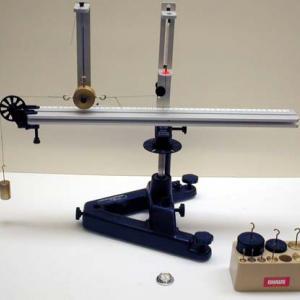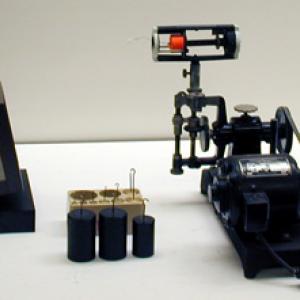College of Liberal Arts & Sciences
1D50.50 - Central Forces - Centripetal Force
Hang weights on the pendulum on the Pasco rotator until it hangs straight up and down. Record that weight and then remove. Now, rotate the apparatus until the pendulum hangs straight down again and record the rotation rate. The force applied by the rotation rate is the same as the static force applied by the weights.
Attach the centripetal force app. to the variable speed rotator. Increase the rpm's on the rotator until the mass in the centripetal force app. extends the spring to the end of the app.. Using the strobe light will provide the stop action viewing necessary for this step. Next hang the centripetal force app. from a hook and hang mass onto the app. until you find how much mass it takes to extend the spring the same amount it was extended when the app. was rotating.
The Max-Air plane is a battery power device that can be connected to a tether in the lecture rooms. LR70 is probably the easiest room to do this in. Centripetal force data can be obtained when the plane is flying in a circle while connected to a scale or force sensor. Charge and discharge the batteries in the plane once. After that, for every second that you charge the plane battery, you will get one second of run time from the plane motor. Charging for 20 seconds or less seems to work well in LR70.
- Sandor Egri, Gabor Bihari, Muhammad Hassan Nawaz, Ayuba Tahiru, "Analyzing Vertical Circular Motion and Damped Oscillations Using a Smartphone Accelerometer", TPT, Vol. 62, #5, May 2024, p. 350.
- James Lincoln, "Way Too Many Demos With the Constant Velocity Car", TPT, Vol. 60, #8, Nov. 2022, p. 710.
- Mark Eichenlaub, "Co-Deriving the Formulas for Centripetal Acceleration and Mass-Spring Period", TPT, Vol. 60, #4, April 2022, p. 258.
- Martin Monterio, Cecilia Cabeza, Arturo C. Marti, Patrik Vogt, Jochen Kuhn, "Angular Velocity and Centripetal Acceleration Relationship", TPT, Vol. 52, # 5, May 2014, p. 312.
- Patrik Vogt, Jochen Kuhn, "Anaylzing Radial Acceleration with a Smartphone Acceleration Senor", TPT, Vol. 51, # 3, March 2013, p. 182.
- Minjoon Kouh, Danielle Holz, Alae Kawam, Mary Lamont, "Wiimote Experiments: Circular Motion", TPT, Vol. 51, # 3, March 2013, p. 146.
- Christian Corrao, "Gamow on Newton: Another Look at Centripetal Acceleration", TPT, Vol. 50, # 3, Mar. 2012, p. 176.
- Alpha E. Wilson, "Jogging on a Carousel", TPT, Vol. 49, # 9, Dec. 2011, p. 570.
- "Figuring Physics: Normal Force and Weight", TPT, Vol. 49, # 8, Nov. 2011, pg. 468.
- David Chesnut, "Centripetal Force Using a Hand Rotator", TPT, Vol. 44, # 9, Dec. 2006, p. 619.
- Donald F. Collins, "Centrifugal Icicles and an Inertial Paradox", TPT, Vol. 42, # 2, Feb. 2004, p. 79.
- John E. Beach, "Centripetal Force on a Turntable", TPT, Vol. 40, #8, Nov. 2002, p. 506.
- Ronald Bryan, "Some Examples of Centripetal Acceleration", TPT, Vol. 40, # 1, Jan. 2002, p. 32.
- Roger F. Larson, "Centrifugal Force and Friction", TPT, Vol. 37, # 7, Oct. 1999, p. 426.
- "Figuring Physics", TPT, Vol. 37, # 8, p. 475, Nov. 1999.
- Alvin H. Bachman, "Comments on Radial Acceleration Derivation", TPT, Vol. 34, # 5, May 1996, p. 260.
- David W. Kraft, Lloyd Motz, "Geometric Derivation of Radial Acceleration Magnitude", TPT, Vol. 33, # 8, Dec. 1995, p. 565.
- Joe Bunn, Jay Smith, "Measure Centripetal Force for Under $3", TPT, Vol. 32, # 6, Sept. 1994, p. 380.
- Volker Thomsen, "Two Problems in Mechanics",TPT, Vol. 32, # 2, Feb. 1994, p. 111.
- Bill Wedemeyer, "Centripetal Acceleration - A Simple Derivation", TPT, Vol. 31, # , Apr. 1993, p. 283.
- "PSSC Physics Rediscovered", TPT, Vol. 31, # 6, Sept. 1993, p. 327.
- Keith Fillmore, 'What Goes Around Comes Around", TPT, Vol. 31, # 9, Dec. 1993, p. 518.
- Paulen A. Smith, "Let's Get Rid of "Centripetal Force", TPT, Vol. 30, # 5, May 1992, p. 316.
- Robert P. Lanni, "Getting Circular Motion Straight", TPT, Vol. 30, # 6, Sept. 1992, p. 325.
- Peter Froehle, "Centripetal Force Provided by Friction", TPT, Vol. 30, # 5, May 1992, p. 299.
- Lee Larson and Roderick Grant, "The Airplane Experiment", TPT, Vol. 29, # 9, Dec. 1991, p. 564.
- Channon P. Price, "Teacup Physics: Centripetal Acceleration", TPT, Vol. 28, # 1, p. 49, Jan. 1990.
- John E. Beach, "Centripetal Force on a Turntable", TPT, Vol. 28, # 2, p. 106, Feb. 1990, reprinted in TPT, Vol. 40, # 8, p. 506, Nov. 2002.
- Angus W. Scott, "Circular Motion and An Inverse Square Machine", TPT, Vol. 27, # 2, Feb. 1989, p. 108.
- Frank Butcher, "Circular Motion Studies with a Toy Airplane", TPT, Vol. 25, # 9, Dec. 1987, p. 572.
- Bill Franklin, "More on Toy Airplane", TPT, Vol. 26, # 5, May 1988, p. 264.
- R.D. Edge, "Levitating a Marble", TPT, Vol. 24, # 5, p. 295, May 1986.
- Paul E. Wack, "Measurement of Centripetal Force Using A Rotating Manometer", TPT, Vol. 23, # 5, May 1985, p. 315 - 316.
- John G. McCaslin, "An Improvement on The Centripetal - Force Apparatus", TPT, Vol. 21, # 3, Mar. 1983, p. 188.
- Anthony Pitucco, "Energy and Centripetal Force for Under Two Dollars", TPT, Vol. 19, # 2, Feb. 1981, p. 121.
- Paul E. Wack, "A Modified Demonstration", TPT, Vol. 19, # 7, Oct. 1981, p. 506.
- Cliff Swartz, "Circular Reasoning", TPT, Vol. 19, # 4, Apr. 1981, p. 220.
- Leon Blitzer, "Circular Reasoning", TPT, Vol. 19, # 6, Sep. 1981, p. 437.
- David Chesnut, "Centripetal Force Using a Hand Rotator", TPT, Vol. 18, # 6, Sept. 1980, p. 466.
- Samuel Jacobs, "New Derivations of a=v2/r ", TPT, Vol. 16, # 3, Mar. 1978, p. 169.
- Russell D. Patera, "Deriving the Centripetal Acceleration Formula: a=v2/r", TPT, Vol. 13, # 9, Dec 1975, p. 547.
- J. A. Moore, "Centripetal force apparatus", AJP, Vol. 43, #5, May 1975, p. 466.
- Ernest Zebrowski, Jr., "On the Derivation of the Centripetal Acceleration Formula", TPT, Vol. 10, # 9, Dec. 1972, p. 527, reprinted in TPT, Vol. 40, # 9, p. 554, Dec. 2002
- "Centripetal-Centrifugal Force Again", TPT, Vol. 3, # 4, April 1965, p. 173.
- Peter Ronhovde, Rudy Sirochman, "Center of Mass Correction to an Error-Prone Undergraduate Centripetal Force Experiment", AJP, Vol. 71, # 2, Feb. 2003, p. 185.
- Isaac Newton and Richard Conn Henry, "Circular Motion", AJP, Vol. 68, # 7, p. 637, July 2000.
- Herbert R. Newhall, "Modified Centripetal Force Apparatus", AJP, Vol. 45, # 5, p. 496, May 1977.
- Robert T. Bush, David M. Durham, "Circular Motion and Centripetal Acceleration in Introductory Physics", AJP, Vol. 43, # 1, Jan. 1975, p. 99.
- John Wessner, "Centrifugal Farce Apparatus", AJP, Vol. 43, # 9, Sep. 1975, p. 838.
- S. J. Williamson, A. Korda, "A New Twist for a Centripetal Force Experiment", AJP, Vol. 40, # 3, Mar. 1972, p. 482.
- Robert Gardner, "Teachers' Pets II - Circling Carts", A Potpourri of Physics Teaching Ideas, p. 67.
- Charles Henderson, "Measuring the Forces Required for Circular Motion", Apparatus for Teaching Physics, p. 51, Edited by Karl Mamola.
- Neil. A. Downie, "Centripetal Force And Centrifugal Projectiles", Ink Sandwiches, Electric Worms and 37 Other Experiments for Saturday Science, p. 131.
- "Innovative Uses", Vernier Software & Technology, The Caliper - Spring 2004
- "The Penny in a Balloon", Physics From the Junk Drawer, 3rd Edition, The Science House, North Carolina State University, p. 25.
Disclaimer: These demonstrations are provided only for illustrative use by persons affiliated with The University of Iowa and only under the direction of a trained instructor or physicist. The University of Iowa is not responsible for demonstrations performed by those using their own equipment or who choose to use this reference material for their own purpose. The demonstrations included here are within the public domain and can be found in materials contained in libraries, bookstores, and through electronic sources. Performing all or any portion of any of these demonstrations, with or without revisions not depicted here entails inherent risks. These risks include, without limitation, bodily injury (and possibly death), including risks to health that may be temporary or permanent and that may exacerbate a pre-existing medical condition; and property loss or damage. Anyone performing any part of these demonstrations, even with revisions, knowingly and voluntarily assumes all risks associated with them.


